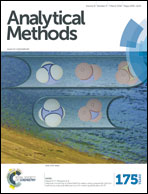A highly sensitive reversible fluorescent-colorimetric azino bis-Schiff base sensor for rapid detection of Pb2+ in aqueous media†
Abstract
A reversible fluorescent-colorimetric azino bis-Schiff based receptor for the detection of Pb2+ in aqueous medium has been developed for the first time. Receptor L exhibits an excellent selective fluorescent-colorimetric rapid response towards Pb2+. The sensitivity of the fluorescence based assay (8 nM) for Pb2+ is sufficiently low in comparison to that previously reported in the literature. From 1H NMR data, the Job plot measurement and the ESI-MS spectrum, 2 : 1 stoichiometric complexation between L and Pb2+ has been established. Microstructural features of L and L + Pb2+ have been investigated by using SEM images for better understanding the interaction between the chemosensor and Pb2+. Receptor L shows remarkable detection ability in a wide pH range of 4–10 and it has been successfully utilised in the determination of Pb2+ in aqueous solution of bovine serum albumin protein. The geometry of L has been optimized both by DFT calculations and single crystal X-ray studies and that of the Pb2+ complex has been optimized by DFT calculations.


 Please wait while we load your content...
Please wait while we load your content...